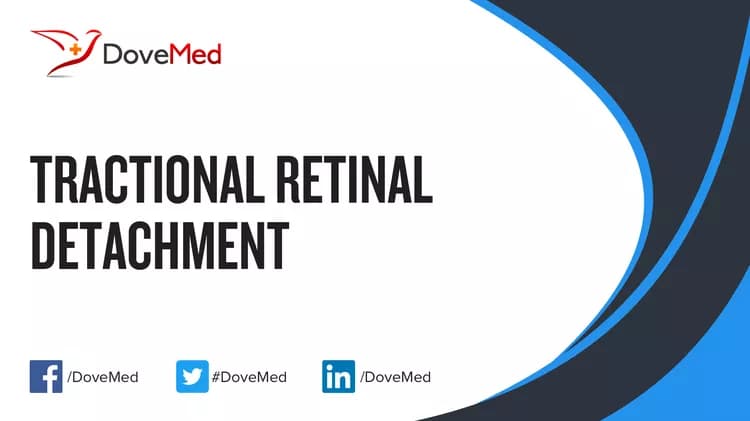What are the other Names for this Condition? (Also known as/Synonyms)
- Retinal Traction Detachment
- Traction Retinal Detachment
- TRD (Tractional Retinal Detachment)
What is Tractional Retinal Detachment? (Definition/Background Information)
- Tractional Retinal Detachment (TRD) is a serious eye condition characterized by the separation of the retina from its underlying supportive tissues due to the formation of fibrous scar tissue on the retina's surface. This scar tissue exerts traction, or pulling force, on the retina, leading to detachment and potential vision loss
- The signs and symptoms of Tractional Retinal Detachment can include sudden vision loss or blurriness, the perception of floaters or dark spots in the visual field, and distortion of vision. The severity of symptoms can vary depending on the extent and location of the detachment
- The diagnosis of Tractional Retinal Detachment is typically made through a comprehensive eye examination by an ophthalmologist. This may involve the use of specialized imaging techniques, such as optical coherence tomography (OCT) or fluorescein angiography, to assess the extent of retinal damage and the presence of scar tissue
- The treatment for Tractional Retinal Detachment often involves surgical interventions to remove the tractional forces and repair the detached retina. Surgical techniques may include a vitrectomy to remove scar tissue and membrane peel, which can relieve the pulling on the retina. In some cases, the surgeon may use intraocular medications to inhibit the formation of scar tissue
- The prognosis for Tractional Retinal Detachment can vary depending on factors such as the extent of retinal damage and the success of surgical intervention. Early diagnosis and prompt treatment are essential to maximize the chances of visual recovery and prevent further deterioration of vision
Who gets Tractional Retinal Detachment? (Age and Sex Distribution)
- Tractional Retinal Detachment (TRD) can occur in individuals of various ages
- It is more commonly associated with advanced diabetic eye disease, specifically in individuals with proliferative diabetic retinopathy
- TRD is not a gender-specific condition, and both males and females are affected
- Worldwide, individuals of all racial and ethnic groups may be affected
What are the Risk Factors for Tractional Retinal Detachment? (Predisposing Factors)
The risk factors for Tractional Retinal Detachment primarily revolve around conditions that promote the growth of abnormal fibrous tissue on the retina, such as:
- Proliferative diabetic retinopathy: Uncontrolled diabetes can lead to abnormal blood vessel growth in the retina
- Retinal vein occlusion: Blockage of retinal veins can result in retinal ischemia and the growth of scar tissue
- Retinopathy of prematurity: Premature infants are at risk due to abnormal blood vessel development in the retina
It is important to note that having a risk factor does not mean that one will get the condition. A risk factor increases one’s chances of getting a condition compared to an individual without the risk factors. Some risk factors are more important than others.
Also, not having a risk factor does not mean that an individual will not get the condition. It is always important to discuss the effect of risk factors with your healthcare provider.
What are the Causes of Tractional Retinal Detachment? (Etiology)
- Tractional Retinal Detachment (TRD) is a type of retinal detachment characterized by the abnormal pulling or traction of the retina away from the underlying tissues
- This pulling is often caused by the formation of scar tissue on the surface of the retina, which can contract and exert force on the delicate retinal tissue
- Conditions that cause abnormal blood vessel growth, inflammation, and retinal ischemia contribute to this process
What are the Signs and Symptoms of Tractional Retinal Detachment?
The signs and symptoms of Tractional Retinal Detachment may include:
- The sudden onset of floaters, flashes of light
- Blurred or distorted vision
- The perception of a curtain-like shadow obscuring vision
Early detection and intervention are crucial to prevent permanent vision loss.
How is Tractional Retinal Detachment Diagnosed?
The diagnosis of Tractional Retinal Detachment may involve the following texts and exams:
- A comprehensive eye examination, including dilated pupil examination
- Slit-lamp examination: This test uses a special instrument, which gives a 3-dimensional picture of various parts of the eye
- Electroretinogram: It makes a record of all electrical signals produced in the retina while the individual is using his/her vision (is seeing)
- The use of imaging techniques, such as ultrasound or optical coherence tomography (OCT) and fluorescein angiography, helps confirm the diagnosis and evaluate the extent of detachment
Many clinical conditions may have similar signs and symptoms. Your healthcare provider may perform additional tests to rule out other clinical conditions to arrive at a definitive diagnosis.
What are the possible Complications of Tractional Retinal Detachment?
- If left untreated, Tractional Retinal Detachment can lead to permanent vision loss
- Additionally, underlying conditions like diabetes can contribute to further complications
How is Tractional Retinal Detachment Treated?
Surgical intervention is often required to repair Tractional Retinal Detachment (TRD). The procedures used in treating TRD may include:
- Vitrectomy
- Membrane peeling
- Use of intraocular gas or silicone oil to stabilize the retina and promote healing
How can Tractional Retinal Detachment be Prevented?
- The prevention of Tractional Retinal Detachment involves effective management of underlying conditions like diabetes to reduce the risk of abnormal scar tissue formation
- Regular eye examinations are crucial, especially for individuals with diabetic eye disease.
What is the Prognosis of Tractional Retinal Detachment? (Outcomes/Resolutions)
- The prognosis of Tractional Retinal Detachment varies based on factors such as the severity of detachment, the success of surgical intervention, and the management of underlying conditions
- Early diagnosis and treatment enhance the chances of preserving vision
Additional and Relevant Useful Information for Rhegmatogenous Retinal Detachment:
The following DoveMed website link is a useful resource for understanding vitrectomy:
https://www.dovemed.com/common-procedures/procedures-surgical/vitrectomy/
Related Articles
Test Your Knowledge
Asked by users
Related Centers
Related Specialties
Related Physicians
Related Procedures
Related Resources
Join DoveHubs
and connect with fellow professionals


0 Comments
Please log in to post a comment.